Kellogg’s Breakfast tomatoes are one of my absolute favorite varieties to grow! They’re a delicious, meaty heirloom that is perfect for tomato sandwiches for those of us who like a less acidic tomato.
The History of Kellogg’s Breakfast Tomatoes
Thankfully, this tomato wasn’t created by the famous cereal brand, but instead, it was introduced by a railroad supervisor and gardener in Redford, Michigan named Darrell Kellogg. He had received the seeds from a from in West Virginia, and loved the variety so much he preserved the breed.
Thanks, Darrell!
They called it Kellogg’s “Breakfast” because the bright orange color and juiciness is reminiscent of orange juice.
Review of the Kellogg’s Breakfast Tomato
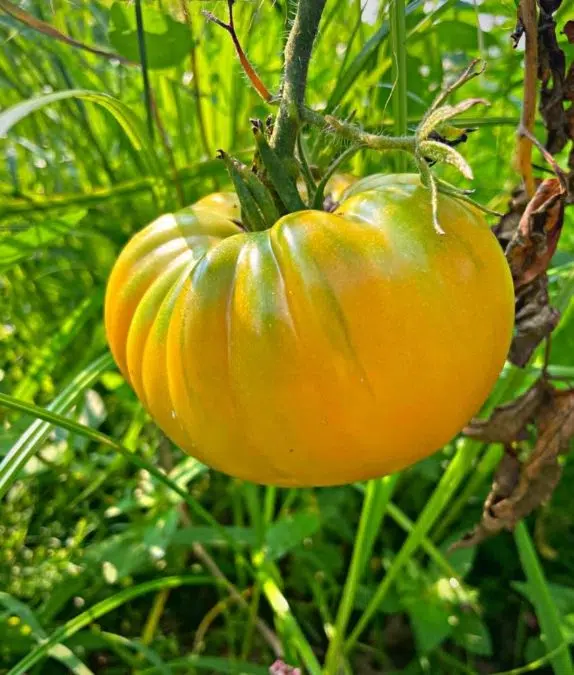
This is one of my favorite tomatoes to grow thus far. It’s got a beautiful orange color and the flavor is sweet, but not super sweet, making it a great addition to more savory meals.
The germination rate of these tomatoes is excellent and I tend to get around 85% germination from the seeds I plant.
- Taste: Tangy-sweet flavor
- Sweetness: 6/10
- Juiciness: 7/10
- Seed Count: Not many in each tomato
- Size: 1-2 pound fruits
- Overall: 9/10
- Will I Grow Again: Absolutely
These plants get quite large and produce tomatoes over 1 pound in weight.
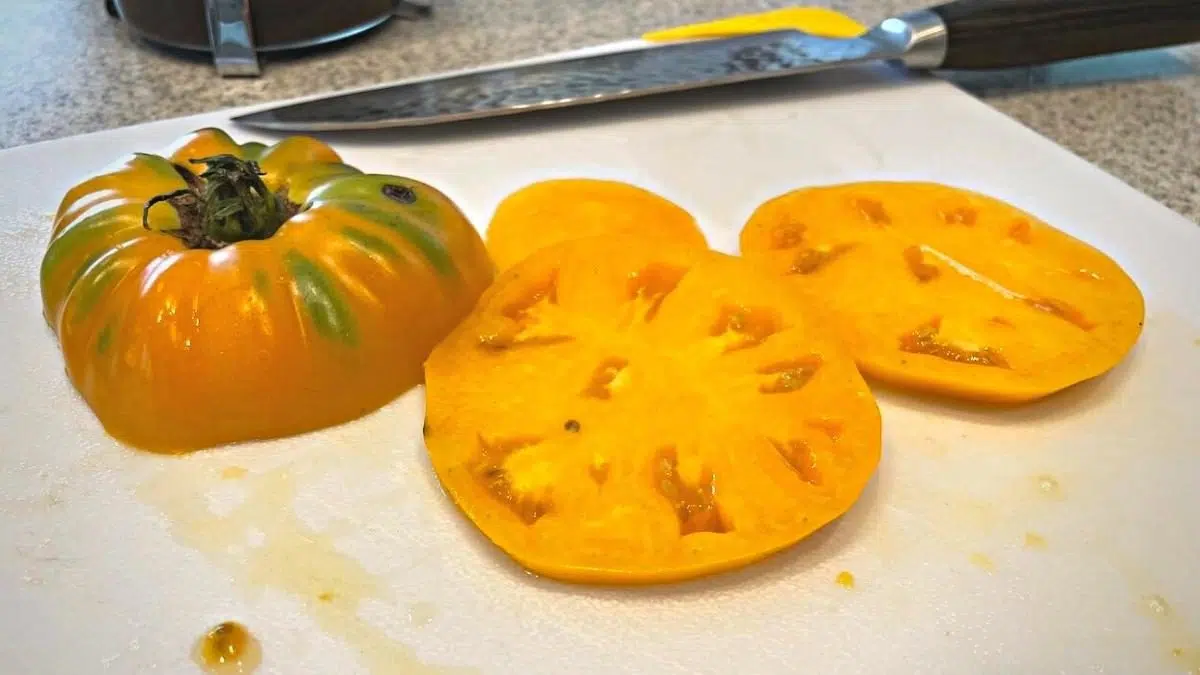
How to Use Them
This tomato is perfect for adding to a breakfast sandwich with bacon and eggs! It adds a little sweetness and crispness without taking away from the rest of the flavors.
Awards and Mentions
- Gary Ibsen’s annual best-tasting tomato by TomatoFest
- Dr. Carolyn Male, the author of 101 Heirloom Tomatoes, lists this variety as one of her favorites
Are Kellogg’s Breakfast Tomatoes Determinate?
Kellogg’s Breakfast are indeterminate tomatoes, meaning they continue to produce fruit throughout the season. The plants can get 6 feet or taller and are quite prolific in terms of a beefsteak variety.
What do Kellogg’s Breakfast Tomatoes Taste Like?
These tomatoes are pretty sweet but have a little tangy flavor as well. Since they are yellow tomatoes, they are less acidic than their red counterparts, but also not as sweet.
How Tall Are Kellogg’s Breakfast Tomatoes?
These tomato plants can get up to 6 or even 8 feet tall if they have enough of a growing season to continue climbing.
How to Grow Kellogg’s Breakfast Tomatoes
To grow Kellogg’s Breakfast tomatoes plant the seeds in good quality soil, in a location that gets 6-8 hours of sunlight per day, and make sure your tomatoes get watered regularly.
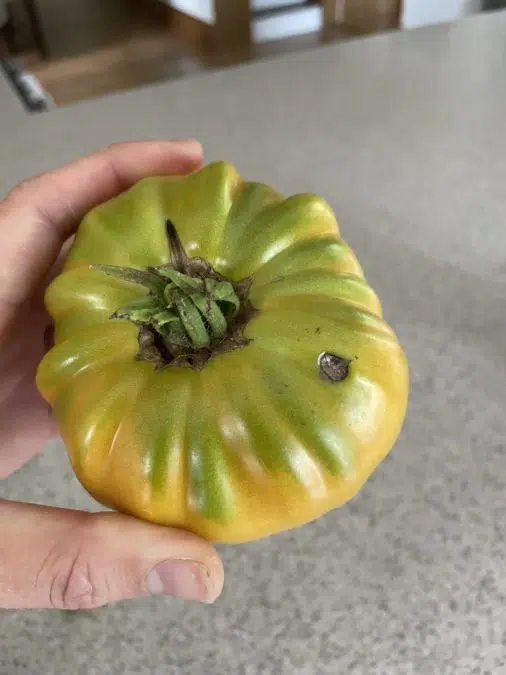
Starting Your Tomato Plant Indoors
Your tomatoes can be started indoors around 6-8 weeks before your area’s last frost date. Starting seeds indoors is a great way to get a headstart on the growing season, and give the plants enough time to grow big and provide you with more tomatoes – isn’t that what we’re all after?!
What You’ll Need to Start Seeds Indoors
- Light Source – most windowsills won’t provide enough light, so I usually use a grow light to give the plants all the light they need and make sure they germinate properly.
- Heat Source – you’re usually starting seeds in the winter, and it can get cold inside. Plants usually need around 70-85 degree temperatures germinate and most homes aren’t that warm, especially in the winter. Heat mats are a great way to make sure you get good germination rates.
- Good Quality Soil – I like this one for a seed starting mix
- Seed Starting Trays – These are hands down the best option for seed starting trays.
- Water – A watering can or hose will work great
- Tomato Seeds – you can get Kellogg’s Breakfast tomato seeds from a number of places – your favorite seed company likely carries them.
Starting seeds indoors is pretty easy. You can start this process around 6-8 weeks before your last frost date. My tomatoes came up like crazy this year and I wished I would have waited for around 6 weeks because the frost persisted past my last frost date.
Here’s how to start seeds inside:
1. Add your potting mix or seed starting soil to a tray, and moisten the soil.
2. Add a few seeds spaced around an inch apart (you can thin them out later).
3. Add a thin layer of soil on top, around 1/4 inch, and spray with a spray bottle to moisten.
4. Place your seed tray on a heat mat to help with germination. Put a grow light overhead and put it on a timer to be on for 8-10 hours a day. Too much light can cause trouble, but not enough light is much worse.
5. Once seeds start germinating and you see sprouts forming, remove them from the heat or else they might end up leggy and weak. Keep them under the grow lights.
6. Keep the soil moist, checking it every day with your finger to make sure it doesn’t dry out.
7. As your plants grow, you’ll want to prune your tomato plants and keep an eye out for tomato suckers, making sure to remove them as they come about.
8. Once your frost date has passed, keep an eye on the 10-day forecast to make sure it really has passed. The dates you find online are estimates, so each year you’ll want to check the weather regularly.
9. Start hardening off your plants about a week before they go into the ground. Your plants are used to perfect conditions inside, and the suns rays are going to be much bright, so you need to acclimate them slowly to the new environment first – starting with an hour or two on a cloudy day, and progressively leaving them outside longer each day. This helps protect young plants from harsh conditions.
10. Once there is no sign of frost in the forecast, you can transfer them into the ground, following the instructions below.
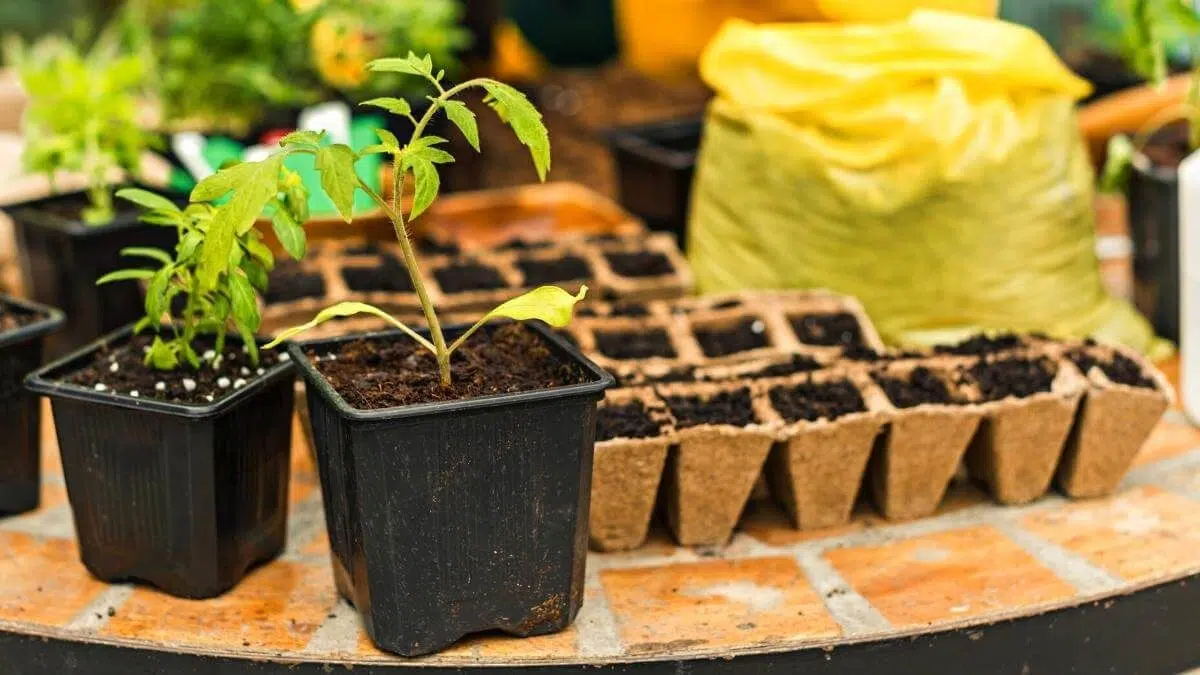
Planting Tomato Seedlings in the Ground
Around 1-2 weeks after the danger of frost has passed, it’s probably warm enough to plant your tomatoes in the ground.
When planning the location for your tomatoes, make sure to choose a location that gets full sun.
Companion planting is another thing to keep in mind when choosing a location, as tomatoes do have quite a few pests and issues to run into. Planting near good companions can help mitigate some of those issues.
Environment & Temperatures
As with most tomatoes, Kellogg’s Breakfast tomatoes can be planted outside when soil temperatures reach at least 50 degrees F.
Soil Requirements
Tomatoes should be planted on rich soils with a pH of 6 to 7 (8 being neutral). They need to have lots of phosphorus, nitrogen, and potassium for good growth and development.
If you want to get your tomatoes off to a great start, improve the soil’s quality and texture by adding in lots of organic matter, like compost and manure.
For best results, I like to grow them in a mixture of peat moss, compost, and vermiculite, known as Mel’s Mix.
Sunlight Requirements for Tomatoes
Tomatoes need at least 8 hours of sunlight in order to grow properly and quickly enough for them to produce a bountiful harvest. Without enough light, your plants can get stunted and grow much slower, which may result in a smaller harvest for you.
Tomato Spacing
Tomatoes need space to grow properly and get enough air circulation to be able to avoid disease and grow a bigger harvest.
Kellogg’s Breakfast are indeterminate tomatoes, meaning they grow tall and continue to produce fruit throughout the growing season. This is important to understand because you should be good with around 24-36 inches between plants.
This year, I planted my tomatoes 1 foot apart in my raised bed, so it is doable, but you need to really stay on top of pruning.
When growing more bushy, determinate varieties, you may need more space between them.
Why can’t you just plant a bunch of plants in one area?
- Reduced airflow can spread disease and make it easier for pests to duplicate
- Decreased sunlight penetration – their leaves will block the sun from other tomato plants around them and vice versa
- Competing for nutrients – tomatoes are heavy feeders, meaning they need a lot of nutrients to produce fruit. Without these nutrients, you might get smaller tomatoes, or even end up with plants that have a lot of foliage, but no flowers.
Mulching
The weather is crazy these days — we’re seeing some of the hottest summers on record, and this can have a huge impact on your tomato plants.
So how do you mitigate this? Using mulch, such as cedar mulch, can be a great way to keep water from evaporating, as well as reduce the impact of high temperatures on your plants and the soil.
Add 1-2 inches of mulch when you initially plant your tomatoes and then add more at least once every few months.
Nutrients & Fertilizers
Tomatoes are heavy feeders, so they need quite a bit of nutrients added into the soil. If you are growing in clay soil like I am, you’ll want to add in dolomite lime and some sort of fertilizer.
Even if you are growing in the loamiest loamy soil (yea, I said it), you’ll probably need to add some kind of nutrients at some point throughout the growing season.
- Nitrogen
- Phosphorous
- Potassium
- Calcium
If your soil is lacking in any of these in the NPK ratio, you’ll run into various problems and end up with a smaller harvest.
Testing your soil is a great way to understand what your soil is high in, and what it might be lacking.
Add tomato fertilizer a few days after planting them in the ground, and then every 2-3 weeks, depending on the instructions you get from the fertilizer manufacturer.
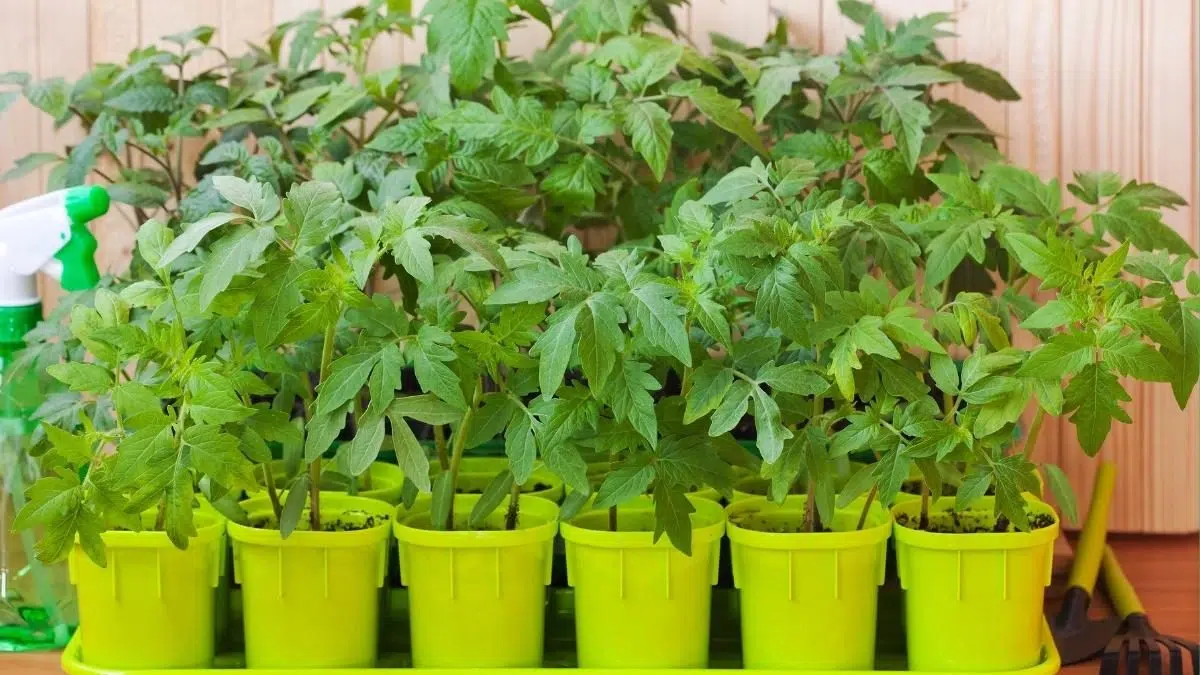
How Deep to Plant Tomatoes
Planting your seedlings in the ground is pretty straightforward, but there is one tip you might’ve missed.
Cut off all the branches aside from the top 2-3. Then plant that long stem in the ground. While it seems wrong, tomatoes are actually quite interesting in the sense that they will grow roots along that main stem underground.
Planting them this way will give your plant stronger roots that will be able to resist wind and other outside elements better.
Trellis/Stakes/Cages
Tomatoes generally need some kind of support as they grow tall. While cages are popular options, they are better for smaller, determinate tomato varieties. Since Kellogg’s Breakfast are indeterminate, they can get quite tall reaching heights of 6-8 feet, and a 5-foot tomato cage just won’t be large enough.
I really like using this trellis method as you can make it taller to fit your plants, whereas a cage has a static height.
Pollination & Harvest
Flowers will appear about 10 days after the tomato plant is large enough to set them, and they should be pollinated at that time.
If your garden doesn’t attract a ton of pollinators (i.e. bees and other flying insects), you can manually pollinate the flowers.
Once flowers are pollinated, the plant will begin producing fruits where the flowers once were.
When to Harvest Kellogg’s Breakfast Tomatoes
I like to pick my tomatoes when they are starting to turn from green to their expected color. But because Kellogg’s Breakfast tomatoes are yellow/orange when ripe, it can be hard to tell when they are ripe and ready to be picked. So how can you tell when they are ready?
Here are pictures of some Kellogg’s Breakfast tomatoes I grew last year.
The first picture where the tomato is still quite green was taken on July 20th. The next one was taken just 4 days later on the 24th and you can see just how quickly it ripened.
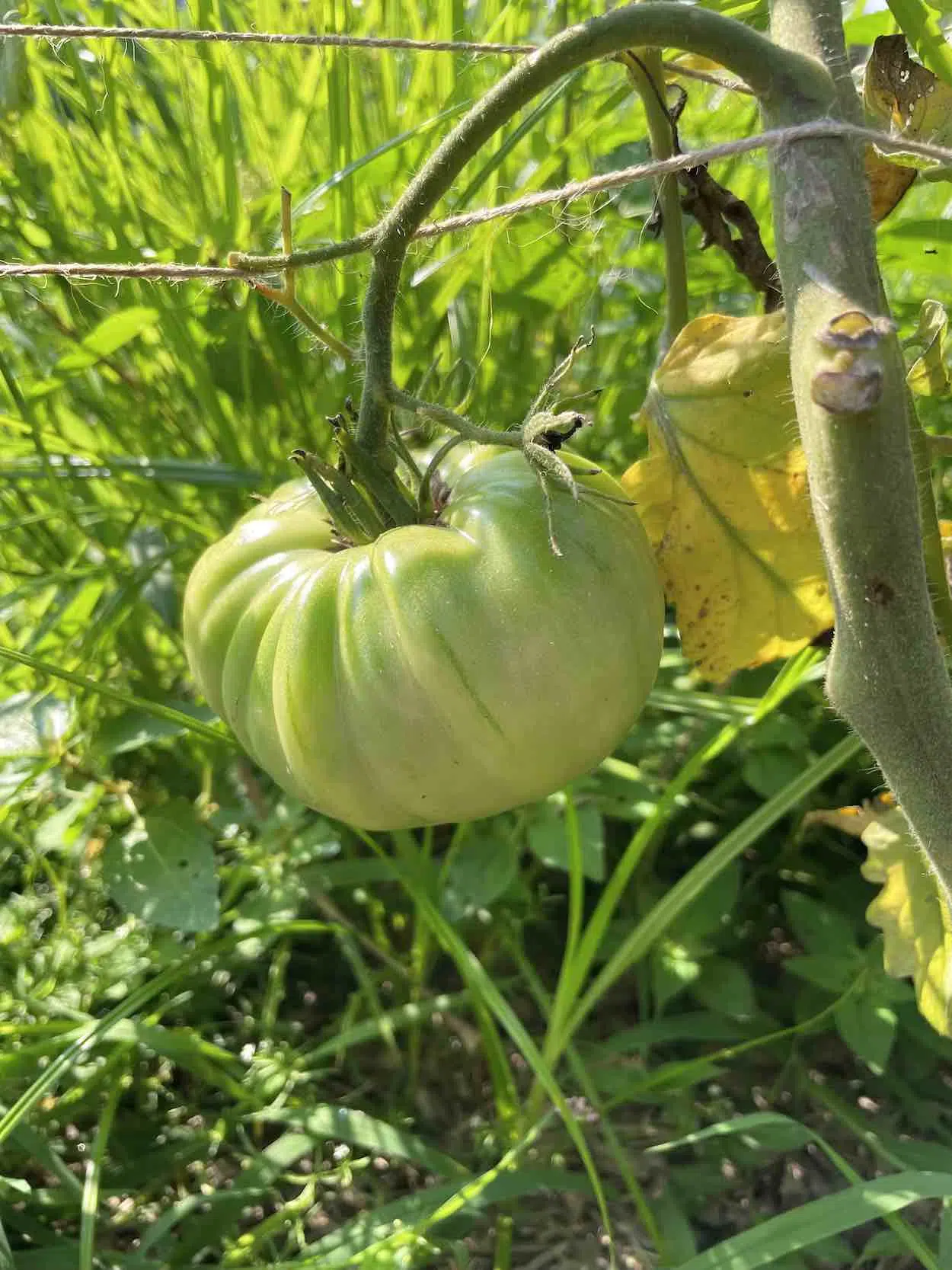
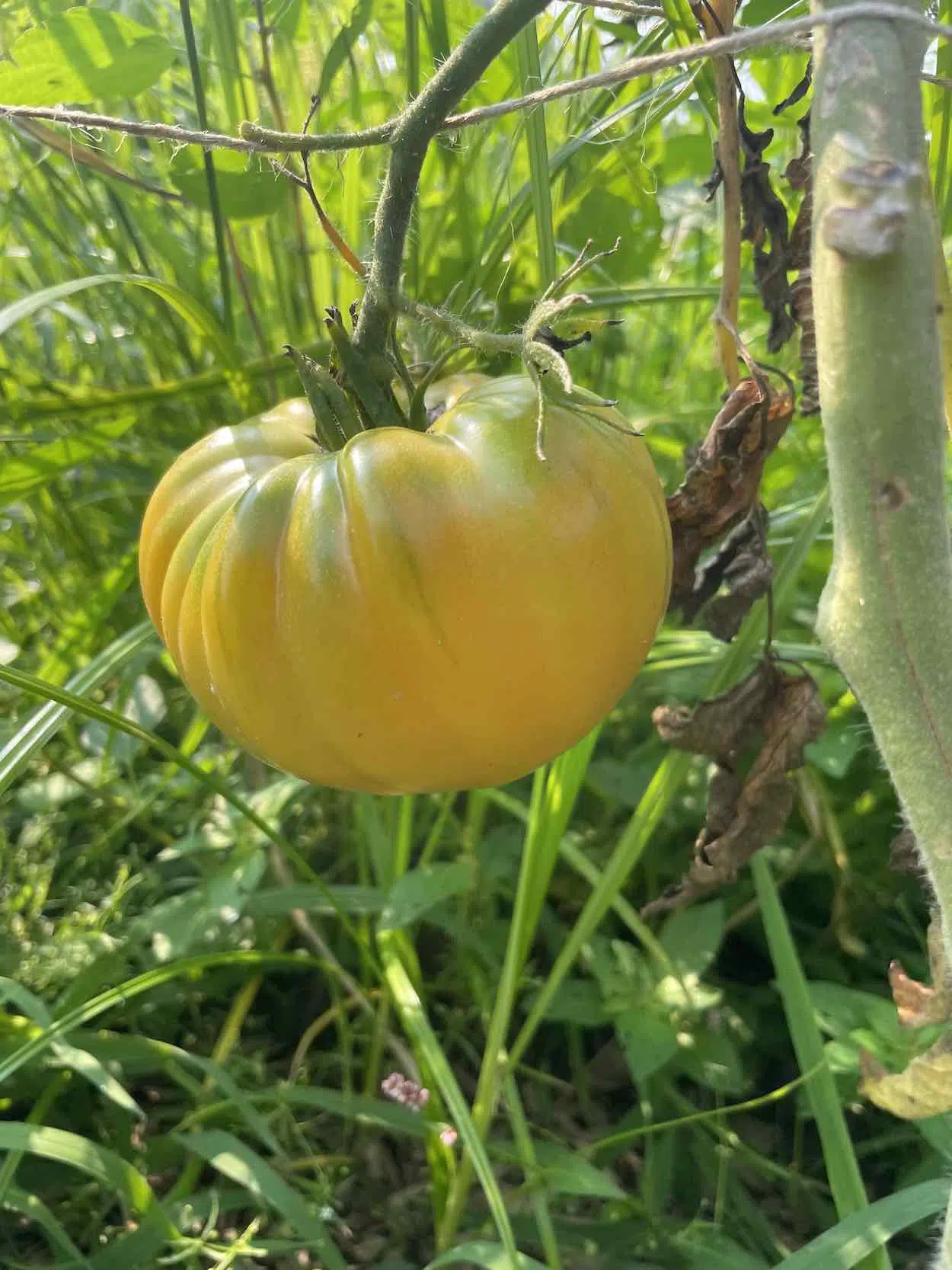
When the tomatoes are starting to turn yellow, they are ready to be picked.
While I waited until this one was fully yellow, you can pick them as soon as the bottom of the tomato begins to turn. This is called the “breaker” stage.
You don’t need to wait until they are fully ripe to pull them off the plant. They will continue to ripen inside on the counter.
Picking them a little early is great because you can avoid a lot of pest pressure from animals that might start realizing how great that tomato must taste.
Common Pests
There are a number of worms that impact tomatoes, including:
- Tomato hornworms
- Armyworms
- Loopers
- Cutworms
All of these worms are pretty gross, and not fun to find in the garden. You can avoid finding them on your plants using a B.t. spray like this one.
Aphids are another pest to watch out for. I call them the glitter of the garden, because they come out of nowhere, multiply like crazy, and can be challenging to get rid of…if you don’t know what you’re doing. Neem oil is a great way to help keep aphids out of the garden.
While there are tons of other pests you might find on your plants, these are some of the more common ones.
But worms aren’t the only ones who eat Kelloggs Breakfast, there are plenty of animals that eat tomatoes including:
- Squirrels
- Birds
- Rabbits
- Deer
- Voles
- Raccoons
Some of My Favorite Tomatoes
While Kellogg’s Breakfast are definitely some of my favorite tomato varieties to grow, there are quite a few others I’d recommend trying to grow in the garden.
- Green Zebra tomatoes
- Paul Robeson
- Tomatillos (not tomatoes, but close!)
- Sun Gold cherry tomatoes
Related Post: How to Grow Tomatoes (Full Step-by-Step Guide)


